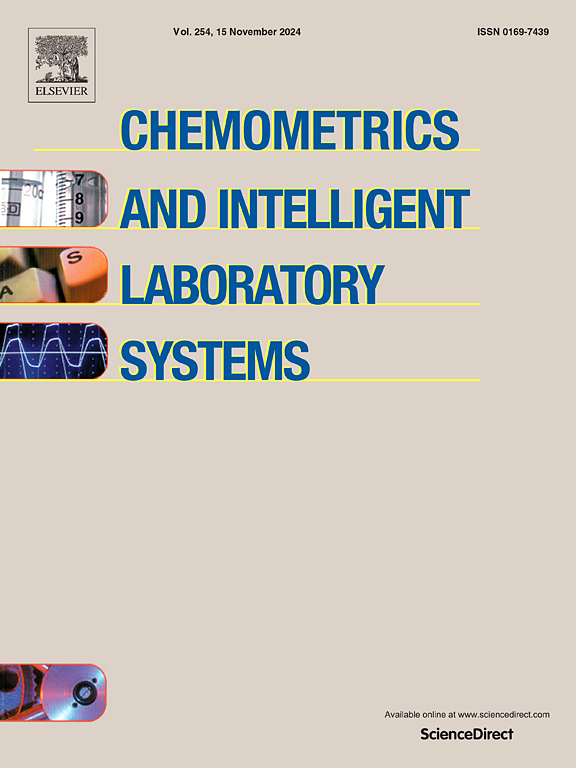Optimizing adsorption efficiency: A novel application of SVM_Boosting_IGWO for methylene blue dye removal using low-cost fruit peels adsorbents
IF 3.8
2区 化学
Q2 AUTOMATION & CONTROL SYSTEMS
Chemometrics and Intelligent Laboratory Systems
Pub Date : 2025-03-10
DOI:10.1016/j.chemolab.2025.105377
引用次数: 0
Abstract
In this work, the potential for employing orange peels (OP) and potato peels (PP) as biosorbents to remove the methylene blue dye (MB) from aqueous solutions is studied. Several physicochemical methods, such as FTIR, SEM-EDX, X-ray diffraction, and pH point of zero charge measurement, were used to analyze the adsorbents. FTIR analysis revealed changes in peak intensities after dye adsorption. SEM analysis confirmed the presence of starch in the PP adsorbent, while no apparent pore structure was observed in the OP adsorbent. EDX analysis showed that carbon and oxygen were the main components on the surfaces of OP and PP. X-ray diffraction patterns indicated that both adsorbents were amorphous materials. The impact of different factors, including adsorbent dosage, contact time, temperature, initial dye concentration, pH and particle size, on the biosorption process was studied. Kinetic studies revealed that equilibrium was reached within a few minutes of contact, and the MB removal followed the pseudo-second-order model.Furthermore, a novel predictive model combining Support Vector Machine (SVM) with Boosting and the Improved Grey Wolf Optimizer (IGWO) algorithm was developed. The SVM-IGWO-Boosting model exhibited excellent performance in predicting methylene blue adsorption, demonstrating perfect correlation and low prediction error. The IGWO optimization approach effectively optimized the input parameters for the adsorbents, resulting in excellent agreement between experimental and predicted values. Moreover, OP showed higher efficiency in removing methylene blue compared to PP, with a maximum capacity of 111.75 mg/g for OP and 96.67 mg/g for PP using IGWO. The use of orange peels and potato peels as agricultural waste for methylene blue removal offers an efficient and sustainable solution. The SVM-IGWO-Boosting predictive model, in conjunction with the IGWO optimization approach, provides a promising tool for predicting and optimizing the adsorption efficiency of MB adsorbents. These findings present valuable prospects for real-world applications requiring accurate and reliable predictions.
优化吸附效率:SVM_Boosting_IGWO在低成本果皮吸附剂中去除亚甲基蓝染料的新应用
这项工作研究了利用橘子皮(OP)和马铃薯皮(PP)作为生物吸附剂去除水溶液中亚甲基蓝染料(MB)的潜力。在分析吸附剂时使用了多种物理化学方法,如傅里叶变换红外光谱、扫描电子显微镜、X 射线衍射和 pH 值零电荷测量。傅立叶变换红外光谱分析显示了染料吸附后峰值强度的变化。扫描电镜分析证实 PP 吸附剂中含有淀粉,而 OP 吸附剂中未观察到明显的孔隙结构。EDX 分析表明,碳和氧是 OP 和 PP 表面的主要成分。X 射线衍射图样表明这两种吸附剂都是无定形材料。研究了不同因素(包括吸附剂用量、接触时间、温度、初始染料浓度、pH 值和粒度)对生物吸附过程的影响。动力学研究表明,在接触几分钟内就达到了平衡,甲基溴的去除遵循伪二阶模型。此外,还开发了一种新的预测模型,该模型结合了支持向量机(SVM)、提升和改进灰狼优化算法(IGWO)。SVM-IGWO-Boosting 模型在预测亚甲基蓝吸附方面表现出色,显示出完美的相关性和较低的预测误差。IGWO 优化方法有效地优化了吸附剂的输入参数,使实验值和预测值达到了极佳的一致。此外,与 PP 相比,OP 对亚甲基蓝的去除效率更高,使用 IGWO,OP 的最大容量为 111.75 mg/g,PP 为 96.67 mg/g。利用橘子皮和土豆皮作为农业废弃物去除亚甲基蓝提供了一种高效、可持续的解决方案。SVM-IGWO-Boosting 预测模型与 IGWO 优化方法相结合,为预测和优化甲基溴吸附剂的吸附效率提供了一种有前途的工具。这些发现为需要准确可靠预测的实际应用提供了宝贵的前景。
本文章由计算机程序翻译,如有差异,请以英文原文为准。
求助全文
约1分钟内获得全文
求助全文
来源期刊
CiteScore
7.50
自引率
7.70%
发文量
169
审稿时长
3.4 months
期刊介绍:
Chemometrics and Intelligent Laboratory Systems publishes original research papers, short communications, reviews, tutorials and Original Software Publications reporting on development of novel statistical, mathematical, or computer techniques in Chemistry and related disciplines.
Chemometrics is the chemical discipline that uses mathematical and statistical methods to design or select optimal procedures and experiments, and to provide maximum chemical information by analysing chemical data.
The journal deals with the following topics:
1) Development of new statistical, mathematical and chemometrical methods for Chemistry and related fields (Environmental Chemistry, Biochemistry, Toxicology, System Biology, -Omics, etc.)
2) Novel applications of chemometrics to all branches of Chemistry and related fields (typical domains of interest are: process data analysis, experimental design, data mining, signal processing, supervised modelling, decision making, robust statistics, mixture analysis, multivariate calibration etc.) Routine applications of established chemometrical techniques will not be considered.
3) Development of new software that provides novel tools or truly advances the use of chemometrical methods.
4) Well characterized data sets to test performance for the new methods and software.
The journal complies with International Committee of Medical Journal Editors'' Uniform requirements for manuscripts.

 求助内容:
求助内容: 应助结果提醒方式:
应助结果提醒方式:


